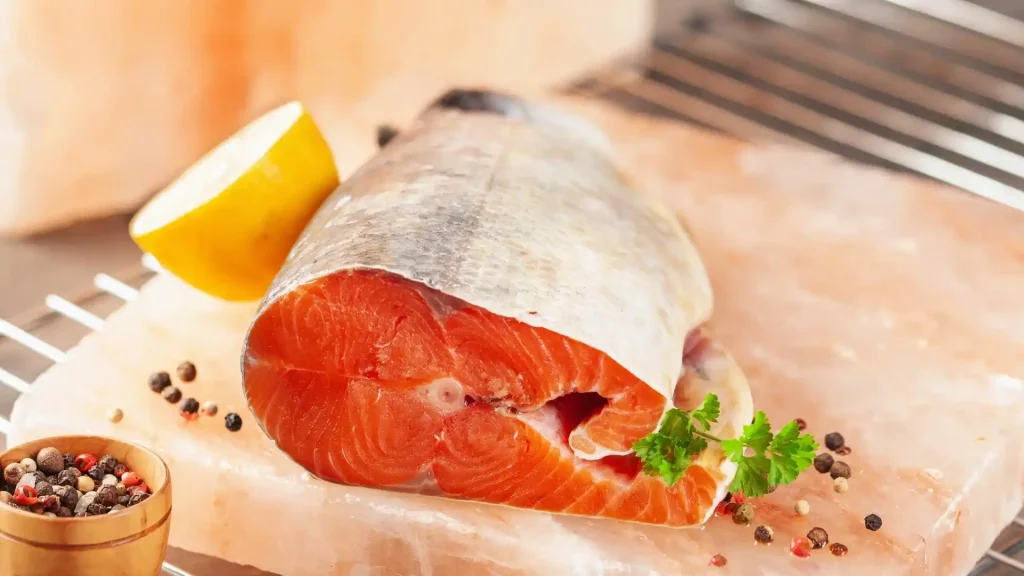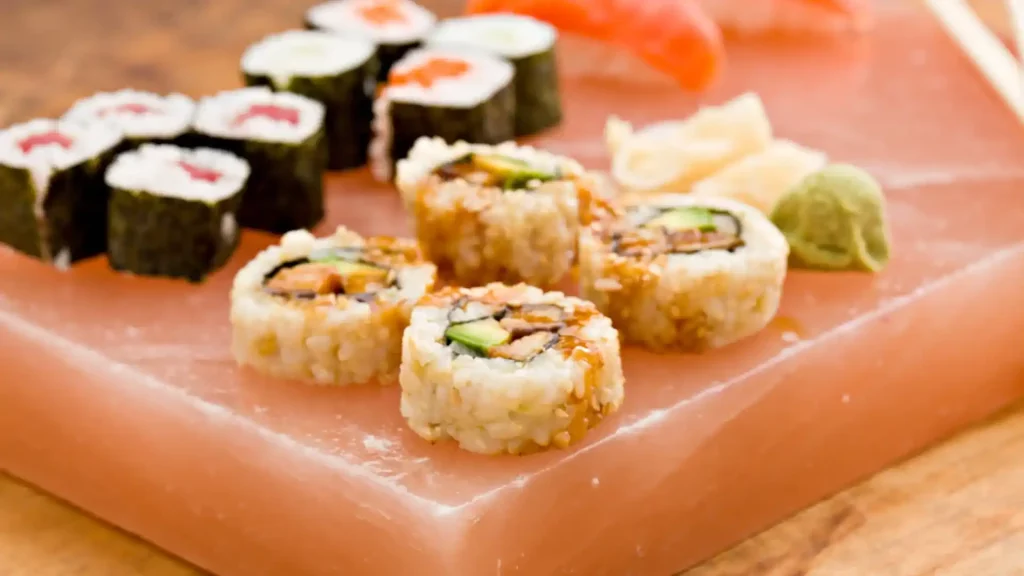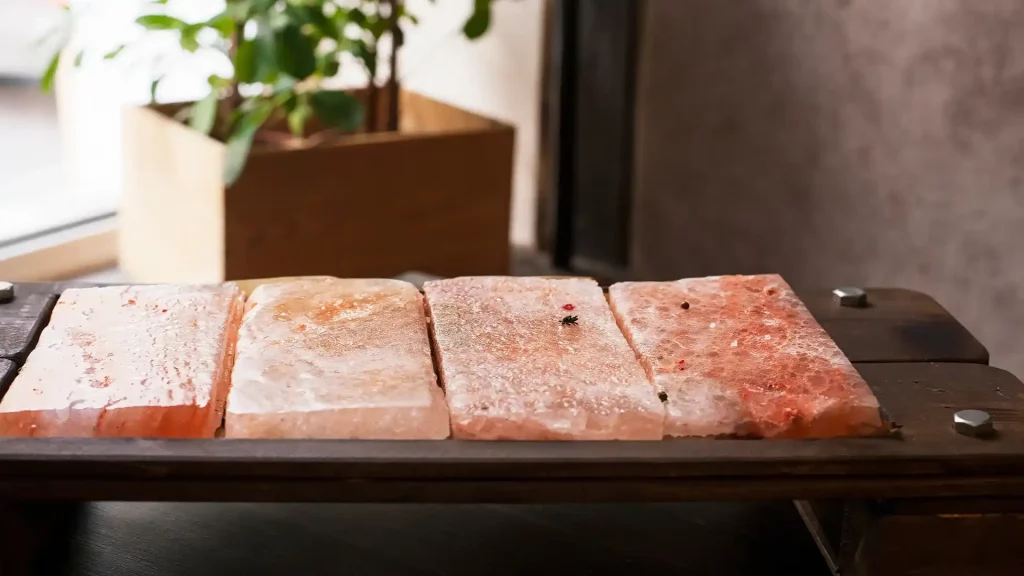
Himalayan salt blocks have become one of the most exciting kitchen tools in recent years. Not only do they look stunning with their rosy-pink hue, but they also add a subtle, natural saltiness to food while offering a unique way to cook, grill, and serve meals. Whether you are a home cook looking to impress guests or a food enthusiast exploring new flavors, learning to use a Himalayan salt block can elevate your culinary game.
In this guide, we’ll cover everything you need to know from preparation and heating to cooking techniques, serving ideas, and maintenance so you can confidently use your salt block for years.
Table of Contents
1. What is a Himalayan Salt Block?
A Himalayan salt block is a thick slab of pink rock salt, usually mined from the Khewra Salt Mine in Pakistan, one of the oldest and largest salt mines in the world. These blocks are hand-cut into flat, rectangular or square pieces, making them ideal for cooking and serving.
They are naturally rich in minerals like calcium, potassium, magnesium, and iron, which not only give the salt its beautiful pink-orange tones but also contribute to the unique flavor it imparts to food.
Read More: How To Cook On Himalayan Salt Slabs
2. Benefits of Cooking on a Himalayan Salt Block
Before we get into the “how-to,” it’s worth understanding why so many chefs love using these blocks:
- Natural seasoning – Salt blocks lightly season your food without overpowering it.
- Even heat distribution – Once heated, they hold temperature well, making cooking consistent.
- Mineral-rich flavor – Adds depth and complexity to dishes.
- Stunning presentation – Ideal for serving appetizers, sushi, cheese, or desserts.
- Versatility – Can be used for cooking, grilling, chilling, and serving.
You might like to read: Understanding the Mineral Composition of Himalayan Pink Salt
3. Preparing Your Himalayan Salt Block
Your salt block needs special handling, especially before the first use:
- Check for cracks – Make sure your block is free of deep cracks or unstable edges.
- Clean gently – Wipe with a damp cloth. Never use soap; the salt will absorb it.
- Dry completely – Moisture and heat don’t mix well on salt blocks, so let it dry fully before heating.
If you have a brand-new salt block, it’s recommended to “temper” it by gradually heating it over a few uses to strengthen its structure.
4. How to Heat a Himalayan Salt Block
Heating your salt block properly is the most important step to avoid cracks:
- Gas stove method
- Place the block on the unlit burner.
- Set heat to low for 15 minutes.
- Increase to medium heat for another 15 minutes.
- Turn to high heat for 15 more minutes.
- Electric stove method
Since salt blocks can crack due to direct contact with coils, use a metal ring or diffuser between the block and heating element. Follow the same gradual heating process. - Grill method
Place the block on a cold grill, then heat gradually.
Tip: The block is ready for cooking when it reaches 400–500°F (200–260°C). A drop of water should sizzle and evaporate instantly.
You may like: How Use Himalayan Salt For Cooking
5. Cooking on a Himalayan Salt Block

When your block is fully heated, you can cook a variety of foods directly on its surface:
- Meat & Poultry – Steaks, chicken breasts, and lamb chops develop a beautiful sear while absorbing a hint of salt.
- Seafood – Shrimp, scallops, salmon, and tuna steaks cook quickly and taste fresh and flavorful.
- Vegetables – Sliced zucchini, mushrooms, asparagus, and bell peppers grill perfectly.
Cooking tips:
- Use thin cuts for even cooking.
- Avoid adding extra salt to your food beforehand.
- Turn food with tongs, not a fork, to preserve moisture.
6. Serving Chilled Dishes on a Salt Block
Himalayan salt blocks can also be chilled in the refrigerator or freezer for cold serving:
- Cold appetizers – Sushi, sashimi, smoked salmon.
- Cheese & fruit platters – The salt enhances sweetness in fruits like watermelon, peaches, and grapes.
- Desserts – Serve ice cream or chocolate truffles for a gourmet touch.
Chilling method:
Place the block in the fridge for at least 2 hours or the freezer for 30–40 minutes before serving.
7. Using Your Salt Block for Grilling
Himalayan salt blocks aren’t just for indoor cooking they shine on the barbecue:
- Preheat the grill with the block in place.
- Cook thin cuts of meat, fish fillets, or vegetables for a smoky, salted flavor.
- For extra flavor, marinate your food before grilling.
Grilling on a salt block gives food a distinctive flavor profile the mineral salt infuses with natural smokiness from the grill.
8. Caring for Your Himalayan Salt Block
Proper maintenance ensures your block lasts for many uses:
- Cleaning – While still warm (but not hot), wipe with a damp sponge or cloth.
- Avoid soap – Salt absorbs soap and will ruin the flavor.
- Dry completely – Store in a dry place to avoid moisture damage.
- Handle carefully – Salt blocks are heavy and brittle; always use two hands.
Pro tip: Over time, the block will develop natural cracks and color changes. This is normal and part of its charm.
9. Safety Tips to Remember
- Never place a hot salt block on a cold surface. The sudden temperature change can cause cracks.
- Do not immerse in water.
- Heat and cool gradually to avoid stress fractures.
- Use a sturdy stand or tray when moving a heated block.
10. Recipe Ideas to Try on Your Salt Block
Here are a few simple ideas to get you started:
- Himalayan Salt-Seared Steak – Heat block to high temperature, cook steak 2–3 minutes per side for a perfect sear.
- Garlic Butter Shrimp – Grill shrimp in garlic butter for a rich, savory taste.
- Grilled Asparagus with Lemon – Drizzle with olive oil and grill until tender.
- Salt-Cured Watermelon & Feta – Serve chilled for a refreshing summer snack.
When you invest in a salt block from Sobaan Salts, you’re getting a long-lasting, versatile cooking tool that will elevate your meals for years.
Read more about: Explore What Is Himalayan Food And Discover Its Delightful Flavors And Dishes
Final Thoughts

Using a Himalayan salt block for cooking, grilling, and serving is both practical and visually impressive. It turns everyday meals into gourmet experiences and introduces a subtle, mineral-rich saltiness that enhances natural flavors without overpowering them.
Whether you’re searing steaks, grilling vegetables, chilling desserts, or presenting appetizers, your Himalayan salt block from Sobaan Salts will become a versatile tool you’ll reach for again and again as long as you care for it properly.
With the tips above, you’re now ready to explore the delicious possibilities a Himalayan salt block offers.
Himalayan salt blocks can reach temperatures up to 500°F (260°C), making them ideal for perfect searing (Serious Eats). Studies show they release trace minerals like calcium and magnesium when heated, potentially enhancing food’s nutritional profile (Source: Journal of Food Science, 2020).
References:
Share This Post
Article By

